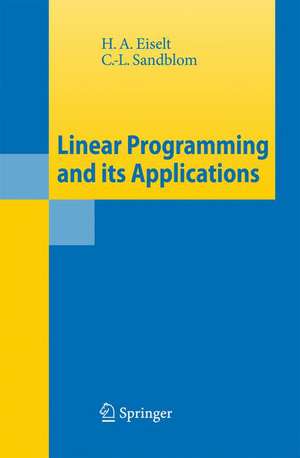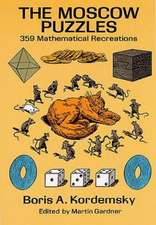Linear Programming and its Applications
Autor H. A. Eiselt, C.-L. Sandblomen Limba Engleză Hardback – 13 aug 2007
| Toate formatele și edițiile | Preț | Express |
|---|---|---|
| Paperback (1) | 949.23 lei 6-8 săpt. | |
| Springer Berlin, Heidelberg – 19 oct 2010 | 949.23 lei 6-8 săpt. | |
| Hardback (1) | 955.40 lei 6-8 săpt. | |
| Springer Berlin, Heidelberg – 13 aug 2007 | 955.40 lei 6-8 săpt. |
Preț: 955.40 lei
Preț vechi: 1165.11 lei
-18% Nou
Puncte Express: 1433
Preț estimativ în valută:
182.84€ • 190.18$ • 150.94£
182.84€ • 190.18$ • 150.94£
Carte tipărită la comandă
Livrare economică 14-28 aprilie
Preluare comenzi: 021 569.72.76
Specificații
ISBN-13: 9783540736707
ISBN-10: 3540736700
Pagini: 396
Ilustrații: XIV, 380 p.
Dimensiuni: 155 x 235 x 29 mm
Greutate: 0.73 kg
Ediția:2007
Editura: Springer Berlin, Heidelberg
Colecția Springer
Locul publicării:Berlin, Heidelberg, Germany
ISBN-10: 3540736700
Pagini: 396
Ilustrații: XIV, 380 p.
Dimensiuni: 155 x 235 x 29 mm
Greutate: 0.73 kg
Ediția:2007
Editura: Springer Berlin, Heidelberg
Colecția Springer
Locul publicării:Berlin, Heidelberg, Germany
Public țintă
ResearchCuprins
Linear Algebra.- Computational Complexity.- Applications.- The Simplex Method.- Duality.- Extensions of the Simplex Method.- Postoptimality Analyses.- Non-Simplex Based Solution Methods.- Problem Reformulations.- Multiobjective Programming.
Recenzii
From the reviews:
"The aim of this book is to focus on the modelling aspects of Linear Programming (LP) … . the book is a good self-contained resource that introduces readers to the vast area of LP and its applications. This book is suitable for a variety of audiences including undergraduate and postgraduate students, practitioners and scientists who are new or relatively new to LP. … Overall … a good introductory book to Linear Programming that combines formal presentations of concepts and techniques with illustrative examples." (D Silva, Journal of the Operational Research Society, Vol. 60, 2009)
"The book intends to present ‘a unified treatment of linear programming’ … . the background of the authors, the kind of the presentation, and the choice of the considered applications indicates that it will primarily attract students and researchers who have interest in operations research and in economical problems. … the main emphasis of the book is on models and applications." (Rembert Reemtsen, Zentralblatt MATH, Vol. 1154, 2009)
"The aim of this book is to focus on the modelling aspects of Linear Programming (LP) … . the book is a good self-contained resource that introduces readers to the vast area of LP and its applications. This book is suitable for a variety of audiences including undergraduate and postgraduate students, practitioners and scientists who are new or relatively new to LP. … Overall … a good introductory book to Linear Programming that combines formal presentations of concepts and techniques with illustrative examples." (D Silva, Journal of the Operational Research Society, Vol. 60, 2009)
"The book intends to present ‘a unified treatment of linear programming’ … . the background of the authors, the kind of the presentation, and the choice of the considered applications indicates that it will primarily attract students and researchers who have interest in operations research and in economical problems. … the main emphasis of the book is on models and applications." (Rembert Reemtsen, Zentralblatt MATH, Vol. 1154, 2009)
Textul de pe ultima copertă
This book presents a unified treatment of linear programming. Without sacrificing mathematical rigor, the main emphasis of the book is on models and applications. The most important classes of problems are surveyed and presented by means of mathematical formulations, followed by solution methods and a discussion of a variety of "what-if" scenarios. Non-simplex based solution methods and newer developments such as interior point methods are covered along with a variety of approaches that incorporate multiple objectives in the model.
Caracteristici
Extended chapter on all major areas of applications Detailed managerial sensitivity analyses With a small and fully formulated case study and an extended chapter that deals with models that incorporate multiple objectives Reader will be able to understand the major phases of the process: the formulation, solution, and the interpretation of the results Includes supplementary material: sn.pub/extras
























